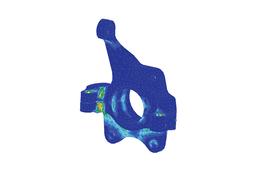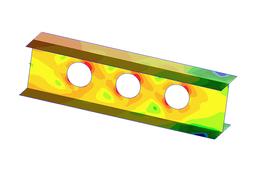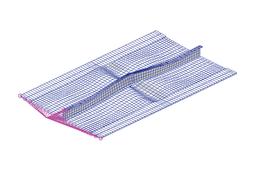
Multidiscipline Simulation Software Supplier, Linear and Nonlinear Finite Element Analysis (FEA), Control Systems Simulation and more
Advanced solutions to model interaction between multiple disciplines for improved accuracy, product safety and reliability
At most companies, CAE is performed as an isolated activity within a single functional team or engineering discipline. The performance, safety, and reliability of their products, however, is greatly influenced by the interactions between these disciplines. Multiphysics FEA can account for some of these interactions, but often the mathematical basis for disciplines are fundamentally different. Multibody dynamics, FEA, and controls systems models, for example, do not share the same numerical foundation, making it difficult to evaluate products from a true system level perspective.
Multidiscipline CAE enables applications from nearly any mathematical regime to share data that enables system level modeling and analysis. Multidisciplinary analysis makes it possible to integrate FEA, controls, multibody dynamics, finite difference, closed form equations, and more, to enable co-simulation across the boundaries of engineering disciplines. Multidiscipline solutions offer interactive analysis for coupled engineering physics such as motion-structures, thermal mechanical, systems and controls, multi-physics, fluid-structure interaction (FSI), composites failure chaining, and more. Our robust solver foundation allows engineers to solve the most complex engineering challenges.
Design of Experiments (DOE) can also assist in enabling co-simulation across multiple engineering disciplines. DOE helps get the design right the first time. Read more about it here.
Depending on the type of analysis, engineers can use MSC solutions in two ways – Direct Coupling (applying multiple physics to the model simultaneously) or Chaining (passing load case results from one analysis to the next).




MSC Software is used for many types of multidiscipline-based simulations:
- Thermal-structural chained analysis
- Perturbation analysis
- Couple thermo-mechanical analysis
- Acoustic-structural coupling
- Motion-structural analysis
- Fluid-structure interaction
- Control system analysis
Industry Uses:
- Aerospace & Defense: Aircraft engines, wings, radomes, landing gear, helicopter fuselage, helicopter rotor blades.
- Automotive: Brake systems, engines, body panels, control systems, suspensions.
- Consumer Products: Sporting goods, packaging, heat sinks for electronic systems, bicycle frames.
- Energy: Wind turbines, solar panels, offshore structures, sub-sea pipes
Motion/Structural Coupled Analysis

MOTION STRUCTURE INTERACTION STRESS IN LOWER CONTROL ARM

MODAL MODEL WITH INTEGRATED FLEXIBLE COMPONENT
Multibody Dynamics (MBD) analysis provides an efficient solution by enabling designers to predict the kinematic (displacements, velocities and accelerations) and dynamic (forces and moments) behavior of mechanical assemblies.
Finite Element Analysis (FEA), on the other hand, can include linear and nonlinear material characteristics of individual components in an assembly, and therefore provides detailed insight into component behavior, including prediction of stress and potential failure.
An integrated MBD/Structures solution from MSC Software offers the best of both worlds: a simple, robust motion model with selected flexible finite element components. Our MBD/Structures solution is built from two of MSC’s core solvers, Adams and MSC Nastran. By integrating these two technologies within a common user environment, MSC Software delivers unparalleled efficiency and accuracy for the multidisciplinary solution of motion-structures problems.
System and Controls

SATELLITE DISH WITH INTEGRATED CONTROL SYSTEM

OPTIMIZING SIZE AND PERFORMANCE FOR A HYDRAULIC PUMP
Thermal/Mechanical coupled Analysis

COUPLED THERMAL-STRUCTURAL (FRICTION) BRAKE SQUEAL ANALYSIS

THERMAL-STRUCTURAL EFFECTS OF WELDING
Understanding the impact of thermal changes and structural responses is important to ensure quality and reliable long term operation for many products. Depending on the size of thermal changes and the materials involved, temperature changes can lead to warping with many unwanted consequences. For example, friction as applied in brake systems creates heat in some areas of the disc structure and these temperature changes may lead to warping which may then be the cause of unwanted noise.
MSC’s thermal/mechanical multidiscipline solutions give engineers the ability to simulate the interaction and effects of structural mechanics and thermal conditions, within a single software product.
Fluid/Structure Interaction

SMOOTH PARTICLE HYDRODYNAMICS

HYDROPLANING SOLVED WITH MSC NASTRAN

DROP TEST OF BLOOD BAG
Related Products:
- Adams The Multibody Dynamics Simulation Solution
- Dytran Explicit Dynamics and Fluid Structure Interaction
- Easy5 Advanced Controls & Systems Simulation
- FEA, AFEA and TFEA Structural, Nonlinear, and Thermal Simulation Packages
- MSC Nastran Multidisciplinary Structural Analysis
- Patran Complete FEA Modeling Solution
- SimDesigner CAD-Embedded Multidiscipline Simulation
- SimXpert Fully Integrated Multidiscipline Simulation Solution
- Sinda Advanced Thermal Simulation Solution


































